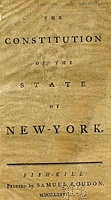The New York Proposition
This November, New Yorkers voted on whether to convene a state constitutional convention, which we are obliged to do every twenty years by state law, and once again, we rejected the referendum, which we have done every opportunity since 1938.
The New York State Constitution, the document that establishes the structure of state government and enumerates the basic rights of its citizens, is a direct descendant of the Magna Carta of 1215 and of a series of grants made to the Duke of York. Since 1801 when the first state constitution was approved, there have been eight additional conventions, each proposing changes to the way New York governs its citizens and what rights they may have. Only four of the conventions resulted in de novo constitutions.
In the 20th century, the proposals of two of the three conventions held were rejected out-right by the voters and some provisions of the third were incorporated in legislation in later years.The eighth convention in 1938 was the first to not propose an entirely new document but instead amended the 1894 version, which is still in effect. At that convention, voters approved the addition of Social Security programs, state funding for the elimination of railroad crossings, excluding New York City from debt limits so it could ἀnance a public rapid transit system, delineating the rights of public works projects workers, and state funding for transportation to parochial schools, among other items.
The last convention was held in 1967. This one was not called by the electorate but by the state legislators, and its proposals were soundly defeated at the polls with every county voting against them.This time, some of the issues that would have been debated had a convention been held were whether New York City should be lopped off the state and the remainder renamed New Amsterdam, gun rights, reproductive rights, ethics reform, restructuring the judiciary, home rule, and consolidating the Assembly and the Senate into a single body. Lots to think about but we have twenty years until we have to decide.


